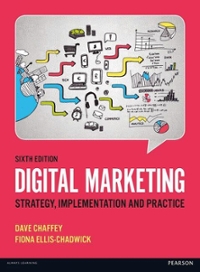Why a case study on Amazon? Surely everyone knows about Amazon and what it does? Yes, well,
Question:
Why a case study on Amazon? Surely everyone knows about Amazon and what it does? Yes, well, that’s maybe true, but this case goes under the surface to review some of the ‘insider secrets’ of Amazon’s early success and a focus on measurement and improvement that remains today
Like eBay, Amazon.com was launched in 1995. The name reflected the vision of founder and CEO Jeff Bezos, to produce a large-scale phenomenon like the Amazon river. This ambition has proved justified since, just eight years later, Amazon passed the $5 billion sales mark – it took WalMart 20 years to achieve this.
On its investor relations site Amazon describes its current mission:
We seek to be Earth’s most customer-centric company for four primary customer sets: consumers, sellers, enterprises, and content creators.
This is now a generic statement, but a previous statements from SEC filings in 2008 is more specific:
Relentlessly focus on customer experience by offering a wide selection of merchandise, low prices and convenience.
This focus on the customer has been there from the start: the 1997 SEC filing said Amazon would ‘obsess over the customer’. Success here is shown by consistently high ratings at the American Customer Satisfaction Index (www.theacsi.org/the-american-customer-satisfactionindex#homelogo). In each SEC filing Amazon explains how it uses an analytical approach to improve satisfaction and business performance by reiterating a comment in a letter to shareholders from Jeff Bezos when Amazon first became a publicly quoted company:
We will continue to measure our programs and the effectiveness of our investments analytically, to jettison those that do not provide acceptable returns, and to step up our investment in those that work best. We will continue to learn from both our successes and our failures.
More recently, this approach has been applied to a range of business model innovations focussed on hardware and new services: Fire Tablet, Smartphone and TV, Echo (voice-activated speaker), grocery delivery in the West coast of the United States, Prime Instant Video, Prime Music, Amazon Fashion and expansion to Amazon Web Services (AWS). Responding to criticism of the Fire Phone, in an interview with Business Insider (2014) Bezos acknowledges that failure will inevitably happen with innovation. He says:
I’ve made billions of dollars of failures at Amazon. com. Literally billions of dollars of failures. You might remember Pets.com or Kosmo.com. It was like getting a root canal with no anaesthesia. None of those things are fun. But they also don’t matter.
Questions
1 By referring to the case study, Amazon’s website for your country and your experience of Amazon offline communications evaluate how well Amazon communicates its core proposition and promotional offers.
2 Using the case study, characterise Amazon’s approach to marketing communications.
3 Explain what distinguishes Amazon in its uses of technology for competitive advantage.
4 How does the Amazon ‘culture of metrics’ differ from that in other organisations from your experience.
Step by Step Answer:






